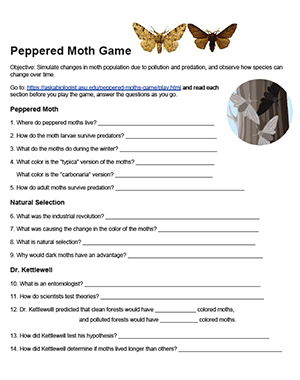
Kettlewell’s observations about the changed in peppered moth populations as as a result of the industrial revolution are common in biology books as an example of observable evolution.
This worksheet was designed as a replacement to an older (similar) worksheet that used a Flash animation. This new version, “Peppered Moth Game” was created by Askabiologist.asu.edu and relies on HTML 5.
Students read about the moths and how they avoid predators by blending into their surroundings. They answer questions as the click through the background information before getting to the “game” which is actually more of a simulation or a modelling activity.
The game has the user playing the role of the bird as it looks for moths on trees. Clicking on the moths changes the population numbers. Students compare how dark and light moths fare in environments with and without pollution.

Finally, students are asked to synthesize their knowledge and understanding of the case and how it relates to evolution by natural selection. This was designed for a freshman level biology class, but could be appropriate for younger students if given guidance on the final questions. In my intro level classes, I would would together with the class to try to write cohesive sentences to answer the final questions. You could also download the google doc and alter it to suit your needs.
Grade Level: 8-12
Time Required: 30-45 minutes
Next Generation Science Standards
HS-LS4-1 Communicate scientific information that common ancestry and biological evolution are supported by multiple lines of empirical evidence
HS- LS4-2 Construct an explanation based on evidence that the process of evolution primarily results from four factors: (1) the potential for a species to increase in number, (2) the heritable genetic variation of individuals in a species due to mutation and sexual reproduction, (3) competition for limited resources, and (4) the proliferation of those organisms that are better able to survive and reproduce in the environment
HS-LS4-4 – Construct an explanation based on evidence for how natural selection leads to adaptation of populations

